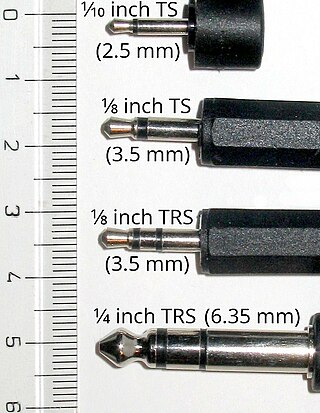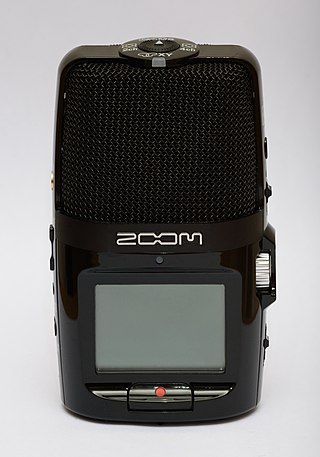
A microphone, colloquially called a mic, is a transducer that converts sound into an electrical signal. Microphones are used in many applications such as telephones, hearing aids, public address systems for concert halls and public events, motion picture production, live and recorded audio engineering, sound recording, two-way radios, megaphones, and radio and television broadcasting. They are also used in computers and other electronic devices, such as mobile phones, for recording sounds, speech recognition, VoIP, and other purposes, such as ultrasonic sensors or knock sensors.

A boombox is a transistorized portable music player featuring one or two cassette tape players/recorders and AM/FM radio, generally with a carrying handle. Beginning in the mid 1980s, a CD player was often included. Sound is delivered through an amplifier and two or more integrated loudspeakers. A boombox is a device typically capable of receiving radio stations and playing recorded music. Many models are also capable of recording onto cassette tapes from radio and other sources. In the 1990s, some boomboxes were available with MiniDisc recorders and players. Designed for portability, boomboxes can be powered by batteries as well as by line current. The boombox was introduced to the American market during the late 1970s. The desire for louder and heavier bass led to bigger and heavier boxes; by the 1980s, some boomboxes had reached the size of a suitcase. Some larger boomboxes even contained vertically mounted record turntables. Most boomboxes were battery-operated, leading to extremely heavy, bulky boxes.

Nagra is a brand of portable audio recorders produced from 1951 in Switzerland. Beginning in 1997 a range of high-end equipment aimed at the audiophile community was introduced, and Nagra expanded the company's product lines into new markets.

Multitrack recording (MTR), also known as multitracking, is a method of sound recording developed in 1955 that allows for the separate recording of multiple sound sources or of sound sources recorded at different times to create a cohesive whole. Multitracking became possible in the mid-1950s when the idea of simultaneously recording different audio channels to separate discrete "tracks" on the same reel-to-reel tape was developed. A "track" was simply a different channel recorded to its own discrete area on the tape whereby their relative sequence of recorded events would be preserved, and playback would be simultaneous or synchronized.

A phone connector is a family of cylindrically-shaped electrical connectors primarily for analog audio signals. Invented in the late 19th century for telephone switchboards, the phone connector remains in use for interfacing wired audio equipment, such as headphones, speakers, microphones, mixing consoles, and electronic musical instruments. A male connector, is mated into a female connector, though other terminology is used.

Hi-MD is a magneto-optical disc-based data storage format. It was a further development of the MiniDisc. With its release in later 2004, came the ability to use newly developed, high-capacity 1 gigabyte Hi-MD discs, in the same dimensions as MiniDisc. The last recorder and player was discontinued in 2011. Blank discs stopped production in September 2012.
Shure Incorporated is an audio products corporation from USA. It was founded by Sidney N. Shure in Chicago, Illinois, in 1925 as a supplier of radio parts kits. The company became a consumer and professional audio-electronics manufacturer of microphones, wireless microphone systems, phonograph cartridges, discussion systems, mixers, and digital signal processing. The company also manufactures listening products, including headphones, high-end earphones, and personal monitor systems.
Zoom Corporation is a Japan-based audio company whose main business is the design and development of electronic devices for music. The company’s products are sold worldwide. Established in 1983, the company is listed on the JASDAQ market of the Tokyo Stock Exchange.
Foster Denki KK is an electronics company that manufactures loudspeakers and audio equipment for other companies or sells them under the trade name Fostex. It is traded on the Tokyo Stock Exchange.

The H4 Handy Recorder is a handheld digital audio recorder from Zoom, featuring built-in condenser microphones in an X-Y stereo pattern, priced from around US$280 depending upon memory capacity as of 2011.

The H2 Handy Recorder is a handheld digital audio recorder from Zoom first announced at the NAMM Show in February 2007. It records very high quality digital stereo or 4-channel audio on a hand-held unit, and has been called "the studio on a stick."

A dictation machine is a sound recording device most commonly used to record speech for playback or to be typed into print. It includes digital voice recorders and tape recorder.

The 1/4 inch Akai is a portable helical scan EIA and CCIR analog recording video tape recorder (VTR) with two video record heads on the scanning drum. The units were available with an optional RF modulator to play back through a TV set, as well as a detachable video monitor. The Akai Electric Ltd. VTR plant was in Tokyo, Japan.

The Zoom H4n is a digital recording device manufactured by Zoom. It is the successor of the Zoom H4 recorder. Both models have two built-in condenser mics arranged in X/Y stereo position and two XLR microphone inputs that double as 1/4 inch phono jacks for musical instruments. Musical applications for the H4N include the ability to use the device as a multi-track (four-channel) recorder; the device also includes tools like a built-in tuner, metronome and effects processor for line-level instruments like guitars.

A Y-cable, Y cable, or splitter cable is a cable with three ends: one common end and two other ends. The Y-cable can resemble the Latin letter "Y".

Sound Devices is an American corporation headquartered in Reedsburg, Wisconsin, with additional offices in Madison, Wisconsin and Rickmansworth, UK. Sound Devices designs and manufactures professional audio and video equipment.

The Zoom H2n is a portable digital sound recording device manufactured by Zoom. It is the successor of the Zoom H2 recorder. The Zoom H2n has four microphone capsules built inside it. Musical applications for the H2n include the ability to use the device as a stereo or multi-track (four-channel) recorder; the device also includes built-in editor for some minor editing works with in the device.
The field of language documentation in the modern context involves a complex and ever-evolving set of tools and methods, and the study and development of their use - and, especially, identification and promotion of best practices - can be considered a sub-field of language documentation proper. Among these are ethical and recording principles, workflows and methods, hardware tools, and software tools.

The Sanyo Micro Pack 35 was a portable magnetic audio tape recording device, developed by Sanyo in 1964, that employed a special tape cartridge format with tape reels atop each other.



















